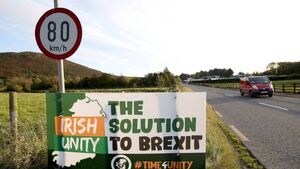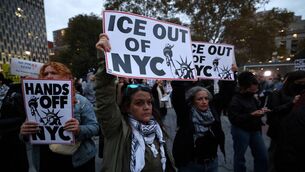There is no easy road to a united Ireland

Motorists pass an anti-Brexit Irish Unity banner as they drive in Dundalk in October 2019. Picture: Paul Faith/AFP via Getty Images
Few events in Irish history have been as crucial as the Good Friday Agreement of 1998, which, forged in the fires of conflict, promised a new dawn for a long-divided nation. Now, a quarter of a century later, we find ourselves at another crossroads, beckoning us to ponder the hitherto unthinkable: a united Ireland.
The Joint Committee on the Implementation of the Good Friday Agreement has released a report that effectively calls for immediate preparations for a united Ireland. This clarion voice ringing through the corridors of the Oireachtas serves as a reminder of how far we've gone while also forecasting the challenging trip ahead.
To understand the depth of the problem, consider Northern Ireland's history. This province is a location where street names may be battle cries, paintings can be both art and weaponry, and ghosts from the past haunt future generations. The Troubles, the euphemistically termed period of sectarian strife, may be in the past, but its spirit lingers in Belfast's little alleys and Tyrone's sweeping hills.
The Good Friday Agreement aimed to exorcise these demons. At its foundation, it was a contract that promised peace through power-sharing and the concept of consent. It was a masterclass in political ambiguity, with both Unionists and Nationalists seeing their goals reflected in the carefully chosen phrases. However, its most revolutionary aspect was the provision for a hypothetical united Ireland, if the people of Northern Ireland so wished.
For years, this provision lay dormant, a sleeping monster in Irish politics. With Brexit having altered the economic and political landscape of these islands, and demographic dynamics gradually but steadily shifting the balance of power, the giant stirs.
The Committee's report goes beyond a formal economic study or a political rallying cry. In many ways, it acts as a mirror for the Irish mind, reflecting our deepest ambitions and concerns. At its root, the call for preparation acknowledges that the vision of a United Ireland has moved from republican fantasy to political reality.
But what would a United Ireland look like? The study wisely avoids painting a too detailed picture, probably because it anticipates that the future canvas would be filled in by many hands. Instead, it advocates for a Green Paper that outlines a vision and encourages widespread public participation on both sides of the border.
This method is both practical and hazardous. Ireland's past is rife with lofty dreams that perished on the rocks of reality. The goal is to create a new Ireland that is more than just a continuation of the Republic, but rather a true synthesis of North and South, of Unionist and Nationalist traditions.
The economic implications of unification are, of course, central to the issue. The study emphasises the performance of the all-island economy, with cross-border trade expanding from €2 billion in 1998 to €12 billion in 2022. This progress underlines the power of peace, but it also emphasises the potential that remains untapped.
However, economics alone cannot build a nation. The report's recommendations for increased coordination in education, energy, and civil service are more than just administrative tweaks; they are the first tentative steps towards knitting together the fabric of a common society. For example, the proposal for a North-South exchange programme for government professionals addresses both cultural contact and bureaucratic efficiency.
The elephant in the room is, without a doubt, Unionism. The report's call for tolerance and respect for all traditions is admirable, but one wonders how it will be received in loyalist strongholds like East Belfast and North Antrim. The Good Friday Agreement establishes the concept of consent, which requires both communities to support any efforts towards unity. The aim will be to create a vision of a United Ireland that does not endanger Unionist identity, but rather provides an opportunity to express it in a new setting.
The true effort begins with the creation of this structure. The report's recommendation for a forum open to all political parties, North and South, recognises the importance of compromise and mutual understanding in achieving unity. It will entail redefining what it means to be Irish, a definition broad enough to include those who have long identified as something other than Irish.
The cultural implications of this process are substantial. Northern Ireland's unique character, forged in the embers of struggle and determined by its position as a border between Britain and Ireland, cannot be easily absorbed into a greater Irish whole. The goal will be to create a new cultural synthesis that recognises the varied traditions of the North and South while also fostering a shared identity for the future.
This reassessment encompasses more than just flags and anthems, though those will undoubtedly be central themes. It involves harmonising multiple approaches to education, healthcare, and social welfare. It is about bridging the gap between a society shaped by decades of conflict and one that has seen unprecedented peace and prosperity. It is about creating a new social contract for the new Ireland.
The report's political implications are, if anything, more widespread. The necessity for speedy preparation challenges the Irish government to move beyond rhetoric and begin planning for future union. This mission will require not simply administrative skills, but also extraordinary political guts.
Sinn Féin, Ireland's long-standing republican party, sees the report as both an opportunity and a problem. Their dream of a United Ireland is now closer to reality than it has ever been, but with that proximity comes the responsibility to explain a vision that can win over not only their committed adherents but also a large segment of Northern Irish society.
The findings pose an existential challenge to Unionist parties. Their old stance of simply opposing any move towards unity may no longer be viable. Instead, they may need to participate in the process to ensure that any plans take into account their concerns and interests.
The British government, for its part, finds itself in an increasingly uncomfortable position. The Good Friday Agreement commits to respecting the will of the people of Northern Ireland, but the prospect of overseeing the disintegration of the United Kingdom is not one that many British MPs would relish. The change in government at Westminster adds uncertainty to an already complex situation.
As we ponder this probable seismic shift in the political landscape of these islands, we should recall the words of John Hume, as quoted in the report: "Ireland is not a romantic dream; it is not a flag; it is 4.5 million people divided into two powerful traditions."
Hume's concept of reconciliation and collaboration between different traditions remains as relevant today as it was during the darkest days of the Troubles.
If it is pursued, the road to a United Ireland will be long and tough. It will require not only political and economic talents but also a fundamental rethinking of what it means to be Irish in the 21st century. The Joint Committee's report is not an endpoint, but rather a call to begin the difficult but necessary process of preparing for a future that, although still unclear, is looming larger on the horizon.
As we continue on this road, we must remember that the actual test of our success will not be redrawing borders or rewriting constitutions, but rather our capacity to establish a society that appreciates and includes all of its members, regardless of background or views. The idea of a United Ireland has long been a driving force in Irish politics and culture. Today's responsibility is to translate that ambition into a vision that will inspire all who reside on this island, not just Nationalists.






